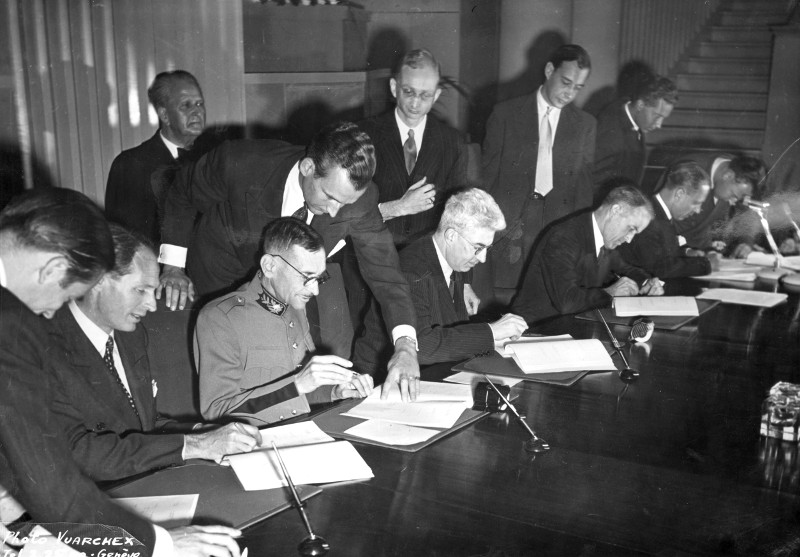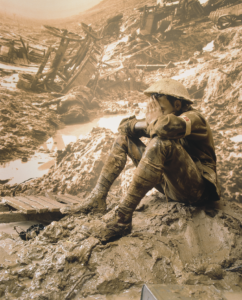How has warfare changed over the past 100 years? Is the international community still sufficiently equipped to reasonably minimize its negative effects on those who require protection? In other words, are international humanitarian law (IHL) and humanitarian action capable of adapting to the changing realities in armed conflict? The International Review of the Red Cross’ recently published edition on The Evolution of Warfare spans from World War I (WWI) to this day, in an attempt to grasp the main patterns of this change. Thematic editor George Dvaladze offers a transversal reading of this edition, focusing on the law applicable to armed conflict.
This post is part of a series on the evolution of warfare.
Over the long history of its existence since 1869, the ICRC’s flagship journal has been called the Bulletin International des Sociétés de Secours aux Militaires Blessés, before becoming the Bulletin International des Sociétés de la Croix-Rouge and later the International Review of the Red Cross (hereafter: the Review). Throughout its changes in name and format, this publication has preserved invaluable information and data that enables the analysis of major evolutions in warfare, law, policy and humanitarian action.
It is precisely for this reason that numerous contributions from this thematic edition are largely based on the articles and reports featured in the Review or its predecessors (see the articles and opinion notes by Daniel Palmieri, Elizabeth van Heyningen, Annette Becker and Lindsey Cameron, to name a few). The Review, that currently serves the humanitarian debate on law, policy and action, has historically published a great deal of content primarily focused on law; in fact, at some points in time it has predominantly published content related to IHL. The latest thematic issue is also particularly rich in terms of diversity of legal topics.
The continued relevance of the law
50 years after the adoption of the Geneva Convention for the Amelioration of the Condition of the Wounded in Armies in the Field (1864), the international treaty that laid foundation of modern IHL, the law was once again put to the test during WWI. As in many armed conflicts before WWI, and many more to come afterwards, the IHL rules have been at times disregarded by the parties to the conflict, and often on a large scale.
The shock, outrage and helplessness triggered by the images of dead or suffering civilians, have naturally brought some to question how seriously the fighting parties take IHL norms; some have even asked if the law itself has ‘eroded’. These questions are still asked today: after all, it was only recently that the ICRC Humanitarium hosted a panel discussion Is the law of armed conflict in crisis and how to recommit to its respect?. Looking into the past, several articles and opinion notes featured in the thematic edition reveal that there is nothing truly new in such discourse. The authors further explore the ways in which fighting parties have tried to temper with or instrumentalize the law, and whether or not their efforts have succeeded in repudiating the validity thereof.
Focusing on the violations of the rules of war during the Battle of Dardanelles (1915), Emre Öktem and Alexandre Toumarkine analyze the policies used by the parties to the conflict that were aimed at creating prejudices against the enemy or belabouring it over the IHL violations it had allegedly committed. They also look at the connection between such policies and the general compliance with the law. Specifically focusing their enquiry on particular areas, such as the use of dum-dum bullets and asphyxiating gases, as well as the attacks on non-military objects and sites, they seek to ascertain the validity of such allegations. They conclude that despite the use of propaganda and other practices of instrumentalization of the law, IHL was continuously taken seriously by the belligerents.
On a related subject, Lindsey Cameron discusses how the ICRC handled the accusations of violations of IHL and engaged into a dialogue with the belligerents during WWI in order to guarantee the implementation of the 1906 Convention on the Wounded and Sick and the 1907 Hague Convention on Maritime warfare.
Anna di Lellio and Emanuele Castano address legal and policy discussions observed among belligerents more recently, in an attempt to propose opposing or modified norms as a revision of IHL that is allegedly more fit for the ‘new’ realities of the battlefield. They suggest that such policies have not weakened the law, but made it even stronger. They also offer an insightful examination of various processes of ‘moral disengagement’ aimed at facilitating violations of the law or publicly justifying them. At the end of their analysis they conclude that “IHL is not just a complex (and increasingly sophisticated) branch of law detached from reality. Rather, it is the embodiment of widely shared principles of morality and ethics, and stands as a normative ‘guardian’ against processes of moral disengagement that make torture and the acceptance of civilian deaths more palatable.”
The evolution of the law
Hand in hand with the evolution of warfare, the law has also undergone significant changes since WWI. These changes occurred in the form of updating, nuancing and modernizing the existing rules, as well as adopting new ones. If one were to identify the main patterns of the development of the law, it would be on one hand the expansion of categories of protected persons and on the other the situations in which they shall be protected.
Jean-Marie Henckaerts, Lindsey Cameron, Bruno Demeyere, Eve La Haye and Heike Niebergall-Lackner, from the Legal Division of the ICRC discuss the project of updating the Commentaries on the Geneva Conventions and their Additional Protocols of 1977, and particularly the recently published Updated Commentary to the First Geneva Convention relating to the protection of the wounded and sick in the armed forces. In an attempt to provide up-to-date interpretations of IHL, the project is aimed at documenting major developments in law and warfare since the first ICRC Commentaries were published.
Rain Liivoja addresses one particular factor that certainly played a crucial, if not the most important role in the evolution of warfare and the law – technological change. He puts forward thought-provoking ideas on the impact of technology on the society at large, and the impact of military technology on warfare in particular.
Writing on what can only be described as one of the most explicit examples of technological change, autonomous weapon systems, Tim McFarland clarifies important technical factors that shape the legal implications of such systems. He advocates that “lawyers should assess ‘autonomous’ systems not according to whether they can act with some degree of independence or whether they display some human-like behaviour, but according to which decisions are delegated to them and how human operators relate to them.”
The plurality of parties to the conflict is not unique to the ‘new realities’. Tristan Ferraro examines the ICRC’s legal position on situations where belligerents are supported in their military operations by one or more third parties, such as States, coalitions of States or international organizations. His analysis is chiefly focused on the notion of armed conflict involving foreign intervention, as well as on determining the law applicable to this type of conflict. Looking further at recent conflicts, the author examines how the degree and nature of support from the intervening power can influence the classification of situations of conflict under IHL.
In their opinion note, Claire Landais and Léa Bass from the French Ministry of Defence reflect on the relationship between IHL and international human rights law (IHRL), and more specifically the role of IHRL enforcement and oversight mechanisms in the implementation of IHL. Focusing on the right to life and the right to liberty and security, they study the recent case law of the European Court of Human Rights (ECtHR) and examine some of the legal issues raised by the concurrent applicability of IHL and IHRL.
For her part, Christian Johannot-Gradis writes on the protection of tangible and intangible cultural heritage in armed conflict. She offers remarkably insightful analyses on intangible cultural heritage mainly expressed through orality, gestures, rituals, music and other forms of expression that individuals create using various media and instruments. She outlines the rules for the protection of such heritage that apart from IHL rules encompasses various human rights treaties and the UNESCO cultural heritage conventions.
Last but not least, in an attempt to foresee the future by looking into the past and the present, this thematic edition of the Review features the ICRC’s report on International humanitarian law and the challenges of contemporary armed conflicts, presented at the 32nd International Conference of the Red Cross and Red Crescent.
***
Warfare has changed, but also stayed the same. The law that regulates the most extraordinary realities has stood the test of time, while undergoing significant changes. Being the ultimate guardian of humanity in times of war, IHL is as relevant in today’s world, as it has been during the past hundred years. And it will retain its importance in the future, for as long as wars are fought.
George Dvaladze is the thematic editor of the International Review of the Red Cross’ issue on The evolution of warfare.
More from this series:
The evolution of warfare: Are we living through the worst period in history? – Vincent Bernard, 15 February 2017.
From ‘false news’ to ‘fake news’: 3 lessons from history – Audrey MacKay, 23 February 2017.
The evolution of warfare, IRRC no. 900
On the occasion of the remembrances marking the 100th anniversary of the First World War, the Review asked historians, legal scholars and humanitarian practitioners to look back at this century of wars from a humanitarian point of view. The contributions collected in this issue illustrate the changing face of conflict by placing human suffering ‒ so often relegated to the backdrop of history ‒ front and centre. They also touch upon positive developments and innovations in the field of humanitarian action and law.
The evolution of warfare is available at www.icrc.org/en/international-review/evolution-warfare.







Comments